Saw handles revisited
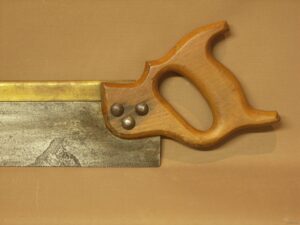
Well, saw handles are more than just grips on a pair of dumbbells. I have owned many saws with handles made from strange substances ranging from crushed pecan shells cast in resin to just plane plastic handles of all types of plastic. The first plastic handles came in in the 60’s as I recall. people use them because they are easy and take no skill to make. No matter how you slice it, composition pecan shells or bone-stiff plastic, nothing compares to a well-made handle from wood.
I use my favourite rasp to enlarge the handle
The post earlier, the one that started this where the handle was cocked all wrong, was about handle position in relation to the saw.
The spokehsave gives me controlled shaping
Now we progress to points of reshaping. First off I want the shape to be custom-shaped to fit my hand and then customised to suit my personality and preferences. I have so many saws I like the look of, but I come down to a design I really like most times. I just got this wonderful rasp that cuts wood like nothing you’ve ever seen. So here is my first level shaping using a half round/flat rasp from Veritas.
This is were I am up to after ten minutes with the rasp and chisel. Now it really fits my hand.


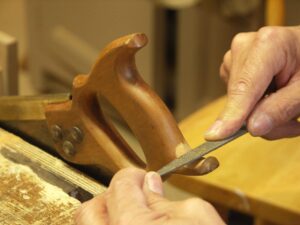
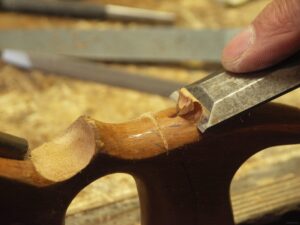
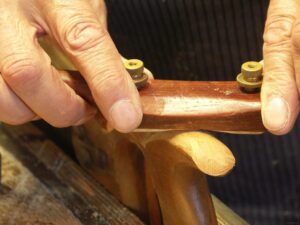
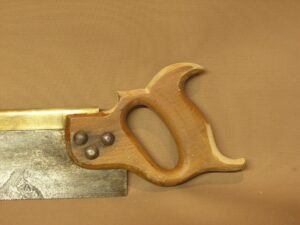
Rasps: Auriou v. Veritas, which is best/best value? Which do you prefer?
A local charity shop once had a bucket of big, very old looking rasps and the like. I didn’t do much woodworking back then but I had a strong sense that I would never see the like of these big, old tools again, so I bought one: the biggest, coarsest rasp (I feared the rest would be scrapped). It is almost 17.5″ long (12″ blade + 5.5″ handle). I originally thought the handle had been (badly) replaced with a dowel held on by a single wrap of wire holding a split together. However, I later came across a tool book on the web that had an identical file with the same style of handle on the cover, the bumph inside said “17th century”!
BTW I read that it is possible to “reinvigorate” old, worn rasps by soaking the “blades” in Hydrochloric acid for a while (which presumably works like the chemical sharpening of fishing hooks). Have you any experience or thoughts on this? I tend to avoid such strong chemicals but I have some oxalic acid (“wood bleach”, a much weaker acid but somewhat stronger than vinegar) for removing tannin stains from wood.
Definitely not hydrochloric acid! The hydrogen can cause hydrogen embrittlement.
The acids to use (in my opinion) are cider vinegar (it doesn’t take on a smell like white vinegar does), white vinegar (if cider vinegar is unavailable), or (if you don’t want to wait for the weaker acids to do the work) a dilute solution of sulphuric acid.
Oh, and clean the rasp thoroughly before attempting any of these methods! Any grease, oils, or dirt on the tool will keep the acid from dissolving the steel uniformly, so part of the rasp might be left untouched. Not ideal.
The sulphuric acid is faster, but much more dangerous, and you must not do it in your shop, lest the fumes cause all the iron and steel in the workshop to develop a nice layer of rust.
Also, when you use the dilute sulphuric acid, make sure you have a container (tall enough to fully immerse the rasp or file) filled with a saturated solution of water and baking soda (add baking soda to water until you can’t dissolve any more into the water, and the water is white) to dunk the rasp into once it’s removed from the acid solution, to neutralize the acid. It will bubble ferociously, but don’t remove the rasp until after the bubbling subsides! Stir it in the container a few times to be certain that the acid is all neutralized.
Also, when you dilute the sulphuric acid, remember to add the acid (slowly!) to the water, never the inverse.
If you decide to go with the weaker acids, it’s much simpler. Just make, or acquire, a container into which the rasp will fit, ideally standing on end, rather than lying on its side. Vertical is better than horizontal.
Then, fill the container with vinegar, place the rasp inside (ideally sans handle), and wait.
There are a number of videos on YouTube about this process, I recommend you check them out. At least one person used muriatic acid (hydrochloric acid, basically, if I recall correctly), but that is very much less than ideal. Old Sneelock (a youtube creator) has an excellent series of videos on the subject of sharpening files with acid. It’s the same principle.
Best of luck! 🙂